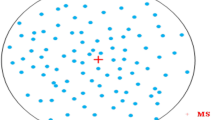Abstract
The Internet of Things (IoT) is a collection of various sensors connected to the internet that share information. In a large-scale IoT network, data is collected through the wireless sensor network (WSN), and the aggregated data is sent from the sink to the next level of IoT for processing. Clustering is utilized to cut down on energy use, network redundancy, interference, and collision in WSN and improve network lifetime, scalability, and data aggregation. In addition, multi-hop communication is more effective for networks with sensors that cover a broad region. The Multi-Hop Low Energy Adaptive Clustering Hierarchy brings about a reduction to the transmission distance and prolongs the network lifetime. This particle swarm optimization (PSO) technique is effective for determining the most effective solutions for a particular problem. The particles in the PSO embody the candidate solutions tend to move through their solutions space (in several directions) in different velocities. A distributed multi-hop cluster-based routing algorithm that takes advantage of the PSO and the Lightening Search Algorithm is developed in this work. The proposed method optimizes the clustering process and achieves energy efficiency, as demonstrated by the experimental results. Reduced end-to-end delay and lower packet loss rate whereas the lifespan network and cluster count are improved.





Similar content being viewed by others
References
Alrabea, A., Alzubi, O. A., & Alzubi, J. A. (2020). A task-based model for minimizing energy consumption in WSNs. Energy Systems.
Sun, M., Zhou, Z., Wang, J., Du, C., & Gaaloul, W. (2019). Energy-efficient IoT service composition for concurrent timed applications. Future Generation Computer Systems, 100, 1017–1030.
Safara, F., Souri, A., Baker, T., Al Ridhawi, I., & Aloqaily, M. (2020). PriNergy: a priority-based energy-efficient routing method for IoT systems. The Journal of Supercomputing, 76, 8609–8626.
Sangeetha, A. L., Bharathi, N., Ganesh, A. B., & Radhakrishnan, T. K. (2018). Particle swarm optimization tuned cascade control system in an Internet of Things (IoT) environment. Measurement, 117, 80–89.
IPantazis, N. A., Nikolidakis, S. A., & Vergados, D. D. (2012). Energy-efficient routing protocols in wireless sensor networks: A survey. IEEE Communications Surveys and Tutorials, 15(2), 551–591.
Xu, L., Collier, R., & O’Hare, G. M. P. (2017). A survey of clustering techniques in wsns and consideration of the challenges of applying such to 5G IoT scenarios. IEEE Internet of Things Journal, 4, 1229–1249.
Alzubi, J. A., Manikandan, R., Alzubi, O. A., Qiqieh, I., Rahim, R., Gupta, D., & Khanna, A. (2020). Hashed Needham Schroeder Industrial IoT based Cost Optimized Deep Secured data transmission in cloud. Measurement, 150, 107077.
Vimalarani, C., Subramanian, R., & Sivanandam, S. N. (2016). An enhanced PSO-based clustering energy optimization algorithm for wireless sensor network. The Scientific World Journal. https://doi.org/10.1155/2016/8658760
Rani, S., Talwar, R., Malhotra, J., Ahmed, S., Sarkar, M., & Song, H. (2015). A novel scheme for an energy efficient Internet of Things based on wireless sensor networks. Sensors, 15(11), 28603–28626.
Rhim, H., Tamine, K., Abassi, R., Sauveron, D., & Guemara, S. (2018). A multi-hop graph-based approach for an energy-efficient routing protocol in wireless sensor networks. Human-centric Computing and Information Sciences, 8(1), 30.
Arioua, M., El Assari, Y., Ez-Zazi, I., & El Oualkadi, A. (2016). Multi-hop cluster based routing approach for wireless sensor networks. Procedia Computer Science, 83, 584–591.
Toor, A. S., & Jain, A. K. (2019). Energy aware cluster based multi-hop energy efficient routing protocol using multiple mobile nodes (MEACBM) in wireless sensor networks. AEU-International Journal of Electronics and Communications, 102, 41–53.
Sung, Y., Lee, S., & Lee, M. (2018). A multi-hop clustering mechanism for scalable iot networks. Sensors, 18(4), 961.
Tukisi, T. W., Mathaba, T. N., & Odhiambo, M. O. (2019). Multi-hop PSO based routing protocol for wireless sensor networks with energy harvesting. In 2019 Conference on Information Communications Technology and Society (ICTAS) (pp. 1–6). IEEE.
Alnawafa, E., & Marghescu, I. (2016). MHT: Multi-hop technique for the improvement of leach protocol. In 2016 15th RoEduNet Conference: Networking in Education and Research (pp. 1–5). IEEE.
Mahmuddin, M., Alabadleh, W. A., & Kamarudin, L. M. (2019). A comparative study on hoping mechanism of LEACH protocol in wireless sensor networks: a survey. In IOP Conference Series: Materials Science and Engineering, 551(1), 012056.
Sony, C. T., Sangeetha, C. P., & Suriyakala, C. D. (2015). Multi-hop LEACH protocol with modified cluster head selection and TDMA schedule for wireless sensor networks. In 2015 Global Conference on Communication Technologies (GCCT) (pp. 539–543). IEEE.
Wang, J., Ju, C., Gao, Y., Sangaiah, A. K., & Kim, G. J. (2018). A PSO based energy efficient coverage control algorithm for wireless sensor networks. Comput. Mater. Contin, 56, 433–446.
Wang, J., Yang, X., Ma, T., Wu, M., & Kim, J.-U. (2012). An energy efficient competitive clustering algorithm for wireless sensor networks using mobile sink. International Journal of Grid and Distributed Computing, 5(4), 79–92.
da Silva, L. G., Knupp, D. C., Bevilacqua, L., Galeão, A. C. N. R., & Neto, A. J. S. (2019). Inverse problem of an anomalous diffusion model employing lightning optimization algorithm. Computational intelligence, optimization and inverse problems with applications in engineering (pp. 185–200). Cham: Springer.
Aghera, K., Pambhar, H., & Tada, N. (2017). MMR-LEACH: Multi-tier multi-hop routing in LEACH protocol. In Proceedings of International Conference on Communication and Networks (pp. 205-214). Springer, Singapore.
Author information
Authors and Affiliations
Corresponding authors
Additional information
Publisher's Note
Springer Nature remains neutral with regard to jurisdictional claims in published maps and institutional affiliations.
Rights and permissions
About this article
Cite this article
Senthil, G.A., Raaza, A. & Kumar, N. Internet of things multi hop energy efficient cluster-based routing using particle swarm optimization. Wireless Netw 27, 5207–5215 (2021). https://doi.org/10.1007/s11276-021-02801-0
Accepted:
Published:
Issue Date:
DOI: https://doi.org/10.1007/s11276-021-02801-0




